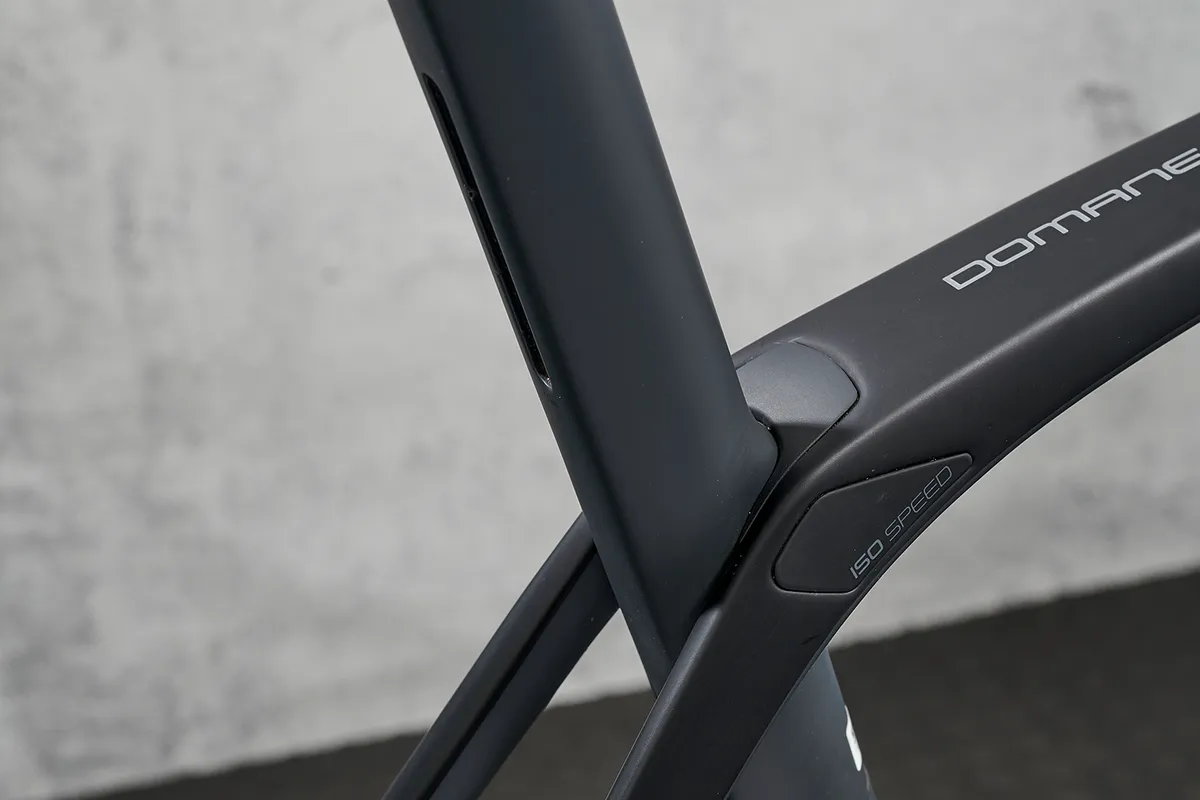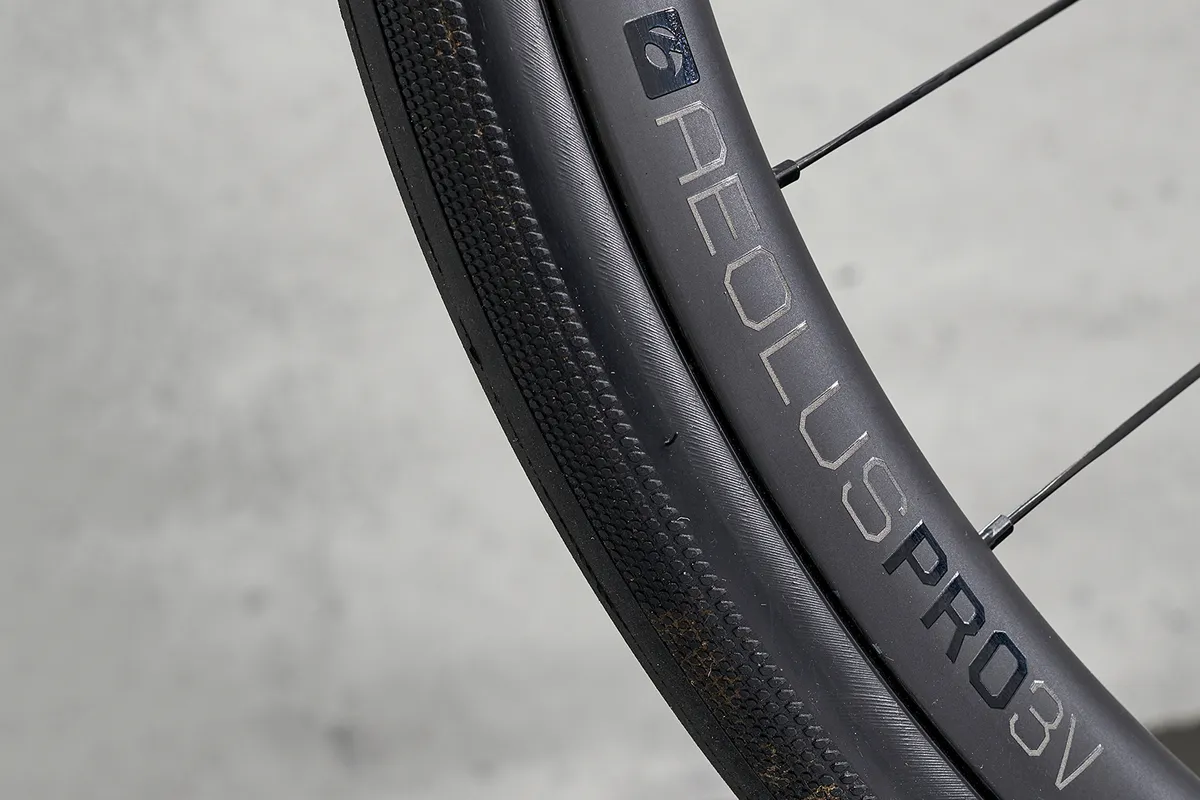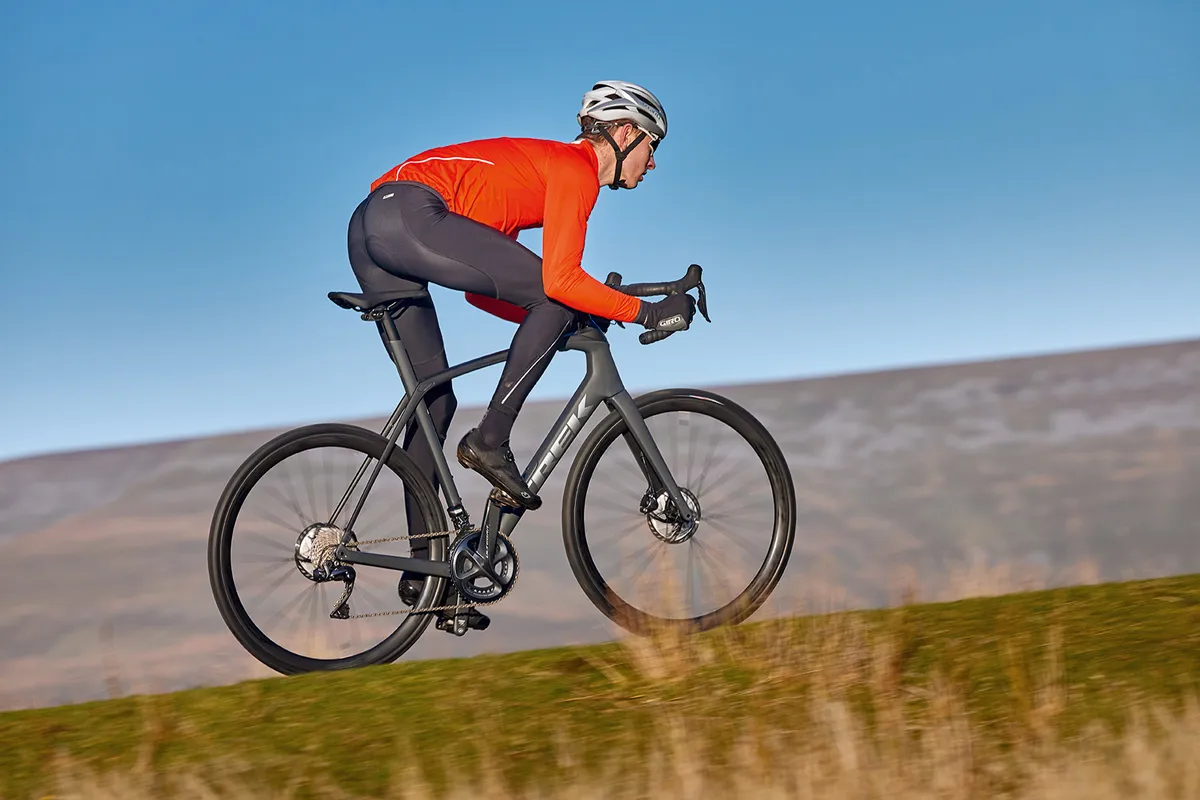The third iteration of the Domane sees significant improvements when it comes to aerodynamics. Looking at the chassis you can see plenty of design influence from the buttery-smooth slipperiness that is the brilliant Madone.
The front end’s sculpted head tube integrates smoothly into the wide fork crown with its huge clearance for 38mm tyres. You’ll find the requisite ISO standard of 4mm clearance for the max-tyre size. The front end has been cleaned up aero wise with all of the cables now running through the bars and around the back of the stem.
This Domane, Trek claims, will save you a minute an hour over the previous generation.

The key feature of the Domane is Trek’s unique IsoSpeed ‘decoupling’ system. At the rear this isolates the seatstays from the seat tube allowing it to flex more freely, giving the rear end a controlled compliance that reacts well to high-frequency vibrations and larger bumps.
The front end sees the traditional headset arrangement replaced with a rocker cup located at the top (of the headset). This design locks in the steerer tube laterally but (like the rear) it allows the steerer to move fore and aft, flexing as you ride over rougher ground. The effect is that the front-end tracks and steers as well as any bike with added compliance over rough surfaces.
The Domane doesn’t lack for extra details, however, and the removable rear bridge and mudguard eyelets give all-weather riding appeal.
Between the down tube bottle cage mount is a flip switch, turn this and the bottle cage section pops out to reveal a storage area big enough for a multi-tool, inflator and tyre levers (that can all be stored in the included bag). It’s a neat storage idea that replaces the need for a saddlebag.
The SL7 uses Trek’s second-tier frameset. Although it’s still made with high-grade 500 series carbon, it lacks the adjustability to the rear end of the SLR model and at a claimed 1365g for the frame it’s 30g heavier than the top model and its 700 series carbon.
The extra weight in the frame is the trade-off for the added comfort, so even though the SL7 was the best-equipped and most expensive bike that I had on test, it was also the heaviest by nearly half a kilo.

The Domane doesn’t ride ‘heavier’ than the competition and much of that is down to the excellent wheels. The Pro 3V wheels retail on their own for £1100, so it’s good to see them on a bike of this calibre.
The 1590g a pair weight is impressive for a 37mm deep aero-optimised wheel. The broad shape, 32.6mm wide externally and a huge 25.2mm wide internally, mates to the 32c R2 tyres perfectly to add hugely to the Domane’s gloriously smooth ride.
The wheels are tubeless ready, although the tyres aren’t. The SL7 would benefit from the added advantage of large volume tubeless tyres. The net weight loss afforded by losing large tubes against their sealant replacement would only add to its great ride.
The SL7 really does cover the ground with blissful ease. The limousine-like ride quality could make for a bland experience. What it does, however, is make for a bike that’s brilliantly surefooted.
The SL7 seems to hunker down into corners and grip for days. Even in pretty adverse damp, drizzly conditions, this Domane has assured handling.

When the road starts to rise, the generous gearing of a compact 50/34 chainset with an 11-34 cassette is welcome. The sharpness of the shifting from the Ultegra Di2 drivetrain means that even shifting on steep slopes out of the saddle is handled fuss-free.
The SL7 has a lot going for it with the advantages of the comfort afforded by the ride. Add to that big tyre clearance and it becomes a valid all-road machine with plenty of gravel potential (with a switch of tyres). It’s no surprise that Trek had a limited-edition ‘gravel’ version of the Domane and this bike has a lot of potential to be a one-bike solution.
However, at £100 short of five grand I’d have liked the SL7 to have been lighter and it should come with tubeless tyres as standard. Nevertheless, this is a sweet handling bike with a truly luxurious ride.
Trek Domane SL7 geometry
- Seat angle: 72.5 degrees
- Head angle: 71.5 degrees
- Chainstay: 41.3cm
- Seat tube: 51cm
- Top tube: 56.5cm
- Head tube: 19.5cm
- Fork offset: 4.75cm
- Trail: 6.5cm
- Bottom bracket drop: 7.8cm
- Bottom bracket height: 27cm
- Wheelbase: 1,016mm
- Stack: 61.1cm
- Reach: 38cm
How we tested
This bike was tested as part of a five bike grouptest of premium endurance machines.
The bikes were tested against each other to find out which one provides the best blend of comfort and performance.
Bikes also on test:
Product
| Brand | Trek |
| Price | £4900.00, $6000.00 |
Features
| Fork | Carbon |
| Stem | Bontrager Pro |
| Chain | Shimano Ultegra HG701 |
| Frame | OCLV 500 carbon |
| Tyres | Bontrager R2 Hardcase Lite 32mm |
| Brakes | Shimano Ultegra BR-R8070 hydraulic disc |
| Cranks | Shimano Ultegra R8000 |
| Saddle | Bontrager Arvada Comp |
| Wheels | Bontrager Aeolus Pro 3V |
| Headset | FSA Integrated |
| Shifter | Shimano Ultegra Di2 Disc R8070 |
| Cassette | Shimano Ultegra 11-34 |
| Seatpost | Bontrager ride tuned carbon |
| Handlebar | Bontrager Elite Isozone VR-CF |
| Bottom bracket | Praxis T47 |
| Available sizes | 50, 52, 54, 56, 58, 60cm |
| Rear derailleur | Shimano Ultegra Di2 |
